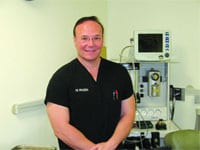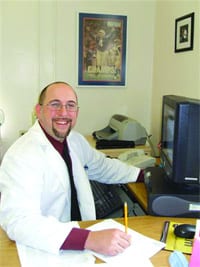Mouth Guard Don’t Ignore That Lump That Won’t Go Away, a Dental Surgeon Says
For some reason, Dr. Richard Fraziero says, too many people can’t be bothered to see the dentist. In fact, roughly half of all people with dental insurance don’t go — and those without insurance even less-often.
“A lot of physicians don’t even go to the dentist; they say, ‘I’m fine.’ If we don’t get ourselves checked out, how can we tell patients to see the dentist once or twice a year to be examined?”
Still, even if they shun the dentist, most people understand the risks — plaque buildup, cavities, even gum disease. But they don’t often think of cancer.
They should, said Fraziero, owner of Facial Cosmetic & Maxillofacial Surgery, P.C. in East Longmeadow. He has given talks about the dangers of oral cancer, which is notoriously difficult to treat once it advances. And the best way to catch it early is to see a dentist regularly, since most cases of early oral cancer are detected by dentists, who are trained to do so.
“Right from the first year of dental school, they are taught to do a comprehensive head, neck, and oral-cancer screening,” he told The Healthcare News. “Part of the reason it’s often diagnosed late is that many people don’t go to the dentist and ignore the signs, and by the time it’s diagnosed, it has already spread to other parts of the neck and body.”
That’s bad news. “Once it’s been diagnosed, it has a 45{06cf2b9696b159f874511d23dbc893eb1ac83014175ed30550cfff22781411e5} fatality rate by five years,” Fraziero said. “Despite all the improvements in cancer detection, the survival rate hasn’t improved in decades. We haven’t been that successful in curing it, and that has to do with the late diagnosis.”
With 35,000 new cases diagnosed every year, oral cancer is the fifth-most-common type of cancer, and about 8,000 people die from it annually. Yet, it doesn’t get the attention that some other cancers do.
“It’s not as popular as talking about breast cancer or some other type of cancers,” Fraziero said. “But other cancers have better detections — for instance, prostate cancer has the prostate-specific antigen test — so the survival rate for oral cancer hasn’t improved despite improvements in technology.”
Silent Killer
Because many people don’t know about the signs of cancers of the mouth — and avoid dentists who do — Fraziero termed the disease a “silent killer.”
“There aren’t a lot of signs of it happening,” he said. “The rule of thumb is, any lesion in the mouth, any lump, bump, or sore, that doesn’t get better within three weeks should be looked at. That’s because the tissue in the mouth totally replaces itself every three weeks.”
Chronic irritation of the mouth tissue is the most common cause of oral cancer, and smoking is among the biggest culprits. “The heat from smoking, the tar, the nicotine, the toxic chemicals, all can be damaging,” Fraziero said, adding that people who use chewing tobacco are in similar danger, as are those — including many people in India — who chew the betel nut to achieve a euphoric feeling.
“Certainly any chronic irritation can lead to some kind of lesion in the mouth,” he said. “While it may not be cancer, in the long term, if it’s not healing, it could eventually turn into cancer.”
Chronic alcohol consumption is another risk factor, and the disease is also related to the human papilloma virus that causes cervical cancer in women. Overall, oral cancer is more common in men than women — by about 2 to 1 — and African-Americans are more prone to it than whites by roughly the same margin. It occurs mainly after age 40.
Common sites for oral cancer to take root include the floor of the mouth, in front, as well as the sides of the tongue. It can show up in the lips as well due to chronic sun exposure.
If a lump or lesion in the mouth seems suspicious, it can be biopsied in a couple different ways, Fraziero said, including with a scalpel. But dentists also have an option called a brush biopsy, which isn’t unlike a pap smear. Cells can be extracted with a minimum of discomfort and evaluated by a computer in a lab; if anything suspicious is uncovered, an incisional biopsy may follow.
Depending on how large and extensive the cancer is, it might be removed in an office setting, or it may require a more serious surgical procedure, followed by radiation and/or chemotherapy. “It’s the adage, ‘small problems get small solutions, and big problems get big solutions,’” he said. Like any cancer, tumors in the mouth are graded on a 1-4 scale for size, and larger tumors require more extensive intervention.
“Unfortunately, the cancer can spread to some areas that are inoperable and not compatible to life to remove it,” Fraziero said. “In that case, we might switch to palliative care to get some quality of life.”
Check It Out
Because people often don’t see the dentist often (if at all), Fraziero recommended occasional self-exams, just like a women might undertake a breast self-exam or a man a testicular check.
“Look inside — you might need a bright light — and anything that doesn’t feel right to you or seems suspicious should be investigated,” he said.
Aside from that, Fraziero suggested simply avoiding the habits that are known risk factors for oral cancer. “Avoid the things that you know cause the problem,” he said. “Remember the adage, ‘everything in moderation.’ One cigar a year won’t kill you, of course, but smoking every day could. Add in alcohol and promiscuous sexual behavior, which can expose you to the human papilloma virus, and you start adding risk factor after risk factor until everything dominoes, and not in your favor.”
He’s especially amazed that young people today continue to light up — studies suggest that about 1,000 Americans under age 18 smoke for the first time every day — considering the wealth of information available about the dangers of cigarettes, not to mention the financial cost.
“Young people have all this information but still choose to smoke,” he said. “My parents smoked, but my generation was lied to — ‘it’s safe for you, go ahead and smoke.’ Now, with all the information we have, it’s amazing that people still choose to do it.”
Last year, the U.S. Food and Drug Administration was given more control over the regulation of tobacco products, and changes in marketing are coming. Starting in 2013, tobacco companies will not be able to display ads in places where children can see them, and will not be able to advertise at all near schools or playgrounds. In addition, the warning label on each pack will become much larger, and cigarette companies will face stricter rules for revealing the ingredients and additives used in tobacco products, including smoke-free alternatives.
The dangers of oral cancer, Fraziero said, as well as how quickly it can become inoperable, should be sufficient reason not to start smoking, and educating young people is important. But far fewer people understand how to recognize cancer in the mouth when it does occur, and he’s doing his part to spread the word.
“Ninety percent of pain in the mouth is tooth-related,” he said. “But it should be looked at so a dentist can rule out anything else.”
It could mean the difference between being a survivor — or a statistic.




Comments are closed.